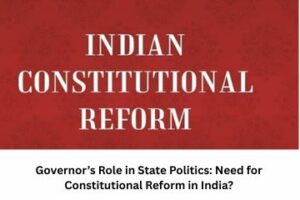Removal of Judges in India: A Cumbersome process and a history of unsuccessful attempts
Written By: Naveen Talawar
Introduction
The question of removal of a Judge before the age of retirement is an important one as it has a significant bearing on the independence of the judiciary. If a Judge of the Supreme Court could be removed by the Executive without much formality, then it can be imagined that the Court would lose its independence and become subject to the control of the Executive. In every democratic country swearing by the Rule of Law, special provisions are made making removal of judges an extremely difficult exercise. In Britain, Judges can be removed only at the address of both houses of parliament, and in the U.S.A., a supreme court judge is removable only by the process of impeachment in case of treason, bribery, or other high crimes and misdemeanors. Likewise, the Constitution of India also made a provision for the removal from a judge of a Supreme Court or high court, However, the process is very cumbersome.
Provision relating to Removal of the judges in higher judiciary
The procedure for removal of a judge in the higher judiciary has been provided under Article 124(4) and the Judges (Inquiry) Act, 1968, This procedure of impeachment is the same for the judges of the supreme court and that of the high court. The combined effect of Article 124(4) and the Judges (Inquiry) Act, 1968 has to be observed for the removal of a Judge.
Article 124 (4) deals with the removal of a judge, it reads as “A Judge of the Supreme Court shall not be removed from his office except by an order of the President passed after an address by each House of Parliament supported by a majority of the total membership of that House and by a majority of not less than two-thirds of the members of that House present and voting has been presented to the President in the same session for such removal on the ground of proved misbehavior or incapacity”.
And to regulate the procedure for the investigation and proof of misbehavior or incapacity of a Judge of the Supreme Court or a High Court, the parliament has enacted the Judges (Inquiry) Act, 1968.
Grounds for removal
Misbehavior and incapacity are the two grounds for the removal of the judge of the Supreme court or that of a High court, these words are neither defined in the constitution nor the Judges (Inquiry) Act,1968. However, in general, parlance misbehavior can be defined as conduct or a course of conduct on the part of the judge which brings dishonor or disrespect to the judiciary’
Provisions under Judges (Inquiry) Act, 1968
Section 3 of the Act provides that if 100 members of the Loksabha or 50 members of the Rajyasabha requests the speaker or the chairman as the case may, presenting an address praying for the removal of the judge then the speaker/chairman may consider the material placed before him and appoint a Committee of three members consisting of :
- One of the Judges of the Supreme Court.
- One of the chief Justices of the High court ., and
- One eminent jurist.
Thereafter the committee shall inform the concerned judge about the charges against him and will allow him to defend himself. And after hearing the concerned judge if the committee concludes that the judge is not guilty of the misbehavior and does not suffer from any incapacity then no further steps shall be taken against him in either house of the parliament. on the other hand, if the committee finds that the judge is guilty of misbehavior or is suffering from incapacity then the motion will be placed before the parliament and if the parliament passes it with the requisite majority then the president shall pass the order for removal of a judge through section 6 of the Act.
Unsuccessful attempts of removing judges in higher judiciary
Till today no judge has been removed by the procedure contemplated under Article 124(4), however, the process was initiated against some of the judges of the Supreme court and that of the High court.
The first judge who faced the impeachment proceedings was Justice V. Ramaswami., in the year 1991, he was accused of misappropriating the public funds when he was chief justice of the Punjab high court however the motion was failed as it did not secure the required 2/3rd of the majority. And in the year 2009, a motion was moved for the removal of Justice Soumitra Sen by 58 members of the Rajya Sabha., it was alleged that Justice Sen has misappropriated 35 lakh rupees as a court-appointed officer in 1993. This motion also failed as Justice Sen resigned from the office before it could be voted in the Lok Sabha.
And again the impeachment proceedings were also initiated against Justice PD Dinakaran in 2011., the allegations made against him were corruption, abuse of judicial office and land grabbing, etc. Justice Dinakaran resigned from the office before the impeachment proceeding could be initiated against him thus resulting in the defeat of the motion.
In 2015, justice JB Pardiwala ran into trouble when he made objectionable remarks on a reservation in one of his judgments, after the impeachment motion was moved against him in Rajya sabha he removed the controversial remarks from the judgment. The same year the impeachment proceedings were initiated against Justice SK Gangele on allegations of sexual misconduct however the sexual harassment charges were not proved against him. In 2016 and 2017. two times the efforts were made to remove Justice CV Nagarjuna Reddy but failed as it did not receive the support from members to initiate removal proceedings. In 2018, the proceedings were about to be initiated against Chief Justice Dipak Mishra but the motion was rejected by the chairman because the complaints were about the internal administration and not misbehavior.
Conclusion
The constitution has created a mechanism that contains the fundamental requirements for the independence of the judiciary. It is clear from the above instances that the process of removal of a judge of a High Court or the Supreme Court is quite laborious and lengthy, unless there is consensus among the members of the parliament the judge cannot be removed.
References
- Chintamani Rout, “Impeachment procedure: Removal of a judge of Supreme court or a High court” 6 Indian Journal of law and Justice (March 2016).
- Rajender Goyal,“Vital Significance of Procedure of Appointment, Transfer, and Removal of Judges in Securing the Independence of Higher Judiciary in India” (8th July 2018), available at https://www.proceeding.conferenceworld.in pdf., (Accessed on 26-09-21)
- Mamta Kachwaha, “The judiciary in India: Determinants of its Independence and Impartiality” pp.21-33 ( PIOOM publishers, Netherlands .,1998 )
- https://www.scribd.com/document/430463766/04-Page-263-409/
- https://www.icj.org/wp-content/uploads/2013/06/India-judiciary-independence-CIJL-report-1998-eng.pdf
- https://www.icj.org/wp-content/uploads/2013/06/India-judiciary-independence-CIJL-report-1998-eng.pdf
- https://www.thehindu.com/news
- https://m.freepressjournal.in
- https://www.thehindu.com/
- https://www.barandbench.com
- https://timesofindia.indiatimes.com

Naveen Talawar
Student at Karnataka State Law University’s Law School
BA.LLB(H)
4th Year
Previous Posts
False rape cases: Infringement of Male Fundamental Rights
Bhopal gas tragedy in relation to Vicarious liability
Judicial Review under Administrative Law
Application Of Promisory Estoppel
Emergency: The Darkest Chapter In Indian Constitutional History




